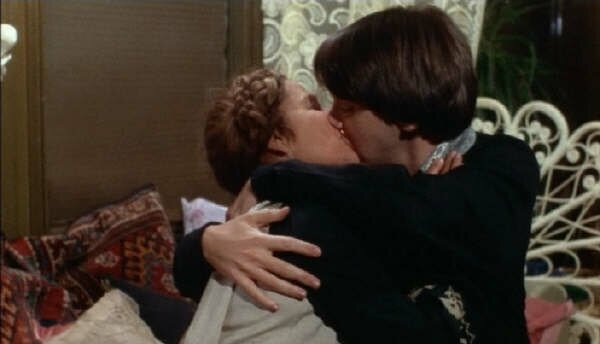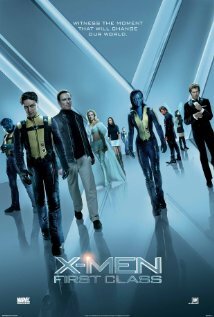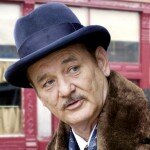I hate to be one to choose something so bleedingly obvious for my very first contribution to this fine website but at the same time, I think there really might be no better starting block (apart from maybe Christmas) for a top 10 list than Valentines Day. Cast your mind out, to every film you’ve seen with a “love interest”, whatever end of the clichéd to avant garde spectrum they may fall. There’s a lot to choose from, yes? A lot of ways to skin a cat, a lot of ways to choose ten films.
At any rate, as someone with a less-than-conventional love life and relationship radar, and as a way to introduce myself to you, here’s a little list from me to you – a filmic antidote to the flowers and chocolate, the sap and sentiment.
What could it possibly be? My top 10 favourite (and therefore, not by any means the MOST) unconventional film couples.
Get ready to be completely smitten.
Or not.
10. Mr Orange & Mr White
Reservoir Dogs (1992)
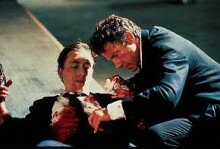
|
Unlikely, no? But dear reader, I put it to you that the relationship between Mr Orange (Tim Roth) and Mr White (Harvey Keitel) is perhaps the soul of Dogs, a relationship that is in turns a rollicking ride through Tarantino dialogue country, and completely heartbreaking. Who would have thunk it, something so touching, at the heart of a film in which the only female character utters no more than a scream and fires a shot. Who needs a conventional courtship? Seasoned pro Mr White takes apparent rookie Mr Orange under his wing, shares a taco with him after explaining the finer points of hostage control. It’s testament to Mr Orange, in actuality an undercover cop, that such a discerning professional falls for his “commode” anecdote, and in the end trusts him enough to reveal his real name. As White holds a dying Orange in his arms, defending him to his last breath, it’s hard not to be touched by the tragic turn the film takes. In fact, I challenge you, the interwebbing public, NOT to be moved when Mr Orange, on the edge of his life, tells White his true identity. You can literally see Keitel’s heart shatter into tiny little pieces. Mr Orange, who began as a wary outsider, the mole within the group, is on par with White during this scene as far as pain, bewilderment and heartache. I know I for one, at first felt angry at Tarantino for ending his film like that, for ruining such a tender moment with a betrayal, then killing all these characters that I had grown to care about. But now, I thank him for slapping (slicing) us in the face with such a film, one that hits us with these characters, tortures them, shoots them, then leaves us to ponder it all, stunned, to the tune of Harry Nilsson.
9. Clarence & Alabama
True Romance (1993)

|
From one Tarantino film to another (although that is a point that is up for argument among many), number nine brings us tumbling into the rollercoaster romance of Clarence Worely (Christian Slater) and Alabama Whitman (Patricia Arquette). Loner comic store clerk Clarence is set up with hooker-with-a-heart-of-gold on his birthday…only problem is, they fall in love. And love was never going to be smooth sailing in something written by ol’ QT. The newly married couple are set upon from all sides almost immediately by all manner of bad guys and good-for-nothings. Of course, this may have something to do with the suitcase full of cocaine that falls into their possession. Alabama’s pimp Drexyl (hilariously portrayed by Gary Oldman), Christopher Walken’s mob boss, as well as the fuzz all want Clarence and Alabama’s asses to be grasses. Clarence though, a trash-culture quoting, geek who has visions of Elvis urging him to do what has to be done, finds his strength grow through the adversity he and his naive (yet completely bad-ass) young bride have to face. My mother commented to me, as I watched this film for the upteenth time, “this movie’s so VIOLENT! What a horrible film!”, but I have to disagree. Not only are he leads completely arresting (so to speak), but the love story that dwells underneath the madness and carnage is so sweet, so unswerving and hopeful. It’s the kind of love that makes you drive across the country away from the law, makes you gaze at the object of your affection (Christian Slater, back when he was cool) as he slaughters those who stand in your way, thinking over and over, “You’re so cool. You’re so cool. You’re so cool.”
8. Howard Bannister & Judy Maxwell
What’s Up, Doc? (1972)
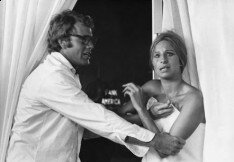
|
They don’t make ‘em like they used to. Peter Bogdanovich’s New Hollywood classic harks back to the days of the 1940s screwball comedy. In fact, What’s Up, Doc? is pretty much a remake of Howard Hawks’ 1938 classic, Bringing Up Baby, starring Katherine Hepburn and Cary Grant. However, I prefer this version. Is that inviting controversy and criticism, going against the great Howard Hawks? No. Writers never do that, invite controversy.
True to the form of the screwball, Doc has slapstick galore, even slapstick set pieces if you will. It all centers around a hotel, and multiple and identical overnight bags, containing books, jewels, classified FBI documents, and Howard Bannister’s (Ryan O’Neal) igneous rocks. The romance of relevance to this list is between O’Neal and Barbara Streisand… although don’t let that fool you, this is – in my opinion – Streisand’s best and most likable performance to date. She – Judy Maxwell – relentlessly pursues Dr Bannister, undeterred by his uptight fiancee Eunice, or the fact that he seems to despise her and the embarrassment she constantly brings. Embarrassment, the law, mobsters with guns, all after the overnight bag they think is theirs. If only such persistance and obsession (through such absurd circumstances) was rewarded so handsomely in the real world. If only. But, this is the world of screwball comedy, and after a crazy dinner party, a shootout and a car chase through San Francisco, Judy and Howard do end up happily ever after. I think if anything, this film gives hope to the slightly crazed, obsessive in all of us, that we might find the kind, handsome doctor of our dreams (or vice versa), even if they well and truly hate and are petrified of us first.
7. Isaac & Tracy
Manhattan (1979)
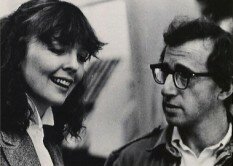
|
For some, watching Manhattan is a slightly uncomfortable exercise considering the well-publicised saga of Woody Allen marrying his wife’s young adopted daughter, but at the same time I think it takes a very cold human being not to be touched by Manhattan. More lyrical in scope than Annie Hall (1977) – probably due to the gorgeous black and white cinematography and the grandiose score, it’s also a more serious look at relationships…without losing that Woody Allen wit. Isaac is in his 40s, a divorcee whose wife left him for another woman. He’s in a loveless relationship with Tracy, a beautiful and intelligent seventeen year old high school student. He soon becomes involved with his friend’s mistress (Diane Keaton), and perhaps falls in love with her…but that’s not the point. No, it’s Tracy to whom he runs across New York for at the end of the film, to tell her not to move to London. His plea to her at the film’s close is quite telling about their relationship, in a few ways. He doesn’t want her to be overseas by herself for six months, because she’ll lose everything he likes about her. As in, her innocence, her youth. To which Tracy replies, “everyone has to get corrupted sometime.” Isaac seems to think that she’s a naive young girl, but in actual fact she is the mature one of the relationship, arguably quite aware that Isaac only liked her for a certain few reasons, and that his profession of love has come as too little, too late. With that knowledge of the dynamics of their relationship, and the fact that Isaac is probably only running back to her because his fling with Diane Keaton’s character has gone awry, there is still something alarmingly touching about seeing this forty year old pleading with a high schooler not to leave, asking over and over if she still loves him. Could it be the music playing in the background? Perhaps. Or the longing look on Allen’s face? Probably.
6. Angela & Emile & Alfred
A Woman is a Woman (Une Femme est Une Femme) (1961)
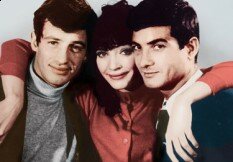
|
I could have been obvious and written about Breathless. Or perhaps Jules et Jim, another love triangle of the nouvelle vague. But obvious is not the game of this list. Une Femme est Une Femme, is Godard, is Anna Karina, is Belmondo…all at their most playful and self-referrential. The film centers on Emile (Jean-Claude Brialy) and his striptease artist girlfriend Angela (Anna Karine, Godard’s gorgeous wife). She wants to have a baby, he doesn’t. Instead, she goes after his best friend, Alfred (portrayed by the effortlessly cool Jean-Paul Belmondo). Sounds sinister, I know. But the film itself is one of the most joyous excursions in romance and fun I’ve ever experienced. Combined with ironic little references to other films and actors of the nouvelle vague, the soundtrack, the performances, the characters all exude the feeling that one finds themselves enveloped in when you’re falling in love with someone. You want to dance, you want to sing, you want to do all manner of silly things. So in effect, this is not so much an unconventional couple (although it is), but more so an unconventional way of portraying said romance to the unsuspecting audience.
5. Enid & Seymour
Ghost World (2001)
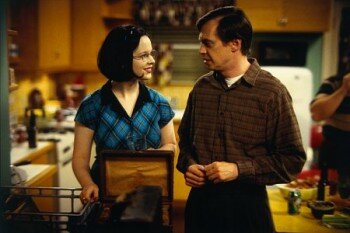
|
Jack: “Ghost World?”
Reb: “Yeah, Ghost World.”
Jack: “Fuck that. Every girl around loves that movie. ‘Oh my god, it’s about ME!’”
I have a confession to make. I fell in love with Steve Buscemi during this film. Well and truly, absolutely. And I also love this movie. Something has to be said about a film that makes you look a little differently at the middle-aged weirdos that hang out at record stores. I acknowledge that a fair few of these listed couples have been spring/autumn romances, but I make no apologies…these are some of the most interesting filmic portrayals of love and/or lust I’ve seen. Enid – a sarcastic high school girl – and Seymour – the aging record collector – enter into a strange sort of friendship, brought about by a mean prank that went on a little too long. Even though by the end of the film, Seymour might just be the last straw before Enid realises she has to leave her home and circle of existence, throughout its running time, Ghost World chronicles quite a poignant connection between two complete outsiders. While her best friend enters the real world, Enid (Thora Birch) remains just as weird, just as unwilling to co-operate as she was during high school. Of course, any number of people can identify with that feeling (whatever my cynical friend says), and it’s a heartwarming scene to watch, when two people, so mismatched yet so alike find each other in the strangest of circumstances.
4. Cop 663 & Fay
Chungking Express (1994)
Although Wong Kar-Wai’s Chungking Express is essentially two separate love stories in one film, and even though they’re both worthy of essays unto themselves (believe me, I know…I wrote one at uni last semester. It was epic), I’m going to focus on the second half, the romance between Cop 663 (Tony Leung) and Fay (Fay Wong). Cop 663, a regular at the Midnight Express, has just been broken up with by his flight attendant girlfriend. Fay’s just started working at the Midnight Express, and spends her days listening to the Mamas and the Papas’ “California Dreamin’” turned up to eleven so she “doesn’t have to think”. After what seems like initial indifference, Fay quickly becomes obsessed with Cop 663, and starts breaking into his apartment, rearranging his possessions in fun-filled, music driven sequences that seem to teeter on the edge of reality and daydream. Did the apartment really flood, start to “cry”? Did Fay really sneak out while he was there, or was that just wishful thinking? The fact that Cop 663 asks out Fay at all seems like a small miracle by the film’s close, considering Fay’s quirky idiosyncrasies, and Cop 663′s seeming inability to move on from his ex (and his straight-laced status as a cop). I think it’s largely due to Faye Wong’s performance that Chungking Express is as charming as it is. Faye is almost overly eccentric, but is also amazingly human. Who hasn’t daydreamed those sort of fantasies before? The only difference here, is that she gets away with it. She rearranges 663′s apartment and life, only to turn around at the last minute and do something similarly as impulsive. 663 though is all the better for it, has begun to move on with his life. The entire film centers on memory and time, and their relationship. Faye though, is constantly looking forward, but without a plan. Don’t worry, I won’t ruin the ending for you the interwebbing public, but rest assured that it won’t be what you’re expecting.
3. Withnail & Marwood
Withnail & I (1987)
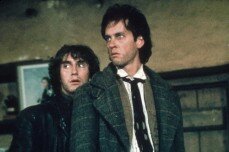
|
Similar to Mr White and Mr Orange, the relationship between Withnail (Richard E. Grant) and Marwood (Paul McGann) walks the edge of a precipice of homosexuality. Certainly, there’s no female characters, certainly, the two leads are rather flamboyant, and certainly Withnail’s Uncle Monty becomes rather smitten with (the admittedly, gorgeous) Marwood, but I would argue that the two men are more so friends that are completely devoted to each other. Two struggling actors, Marwood seems to be swept up in the wake of Withnail, his charismatic and alcoholic roommate. Together they attempt to escape the mess and downward spiral of their apartment and their lives by taking a weekend in the country. Unfortunately what that entails is a rather horny uncle, hideous weather and unfriendly locals. Again, all the two men have is each other, literally huddling together through the night, them against the world. Essentially, Bruce Robinson’s Withnail & I can be seen as a tale of, “you don’t know what you’ve got till it’s gone”, from the point of view of both men. Marwood narrates, but at the film’s close, when he leaves for a faraway acting job, Withnail is left alone in the rain with a bottle of wine, reciting Hamlet to an invisible audience. For while Withnail might have been holding back the more “together” Marwood in more ways than one (in life and professionally), Withnail is the type of companion that only comes around blue moon, someone whose spell one needs to be under, however destructive it may be. Flamboyant, alcoholic, loyal and compltely unhinged. That is the tragedy of their relationship, that they cannot continue to be together, one has to move forward, leaving the other behind.
2. Clarice Starling & Hannibal Lecter
the Silence of the Lambs (1991)
Honestly. I don’t think there’s anything more unconventional than a psychopathic cannibal and a rookie FBI agent. Should I even bother going into the plot of the film? I’m sure you’ve all seen it. It’s a classic. And besides, it’s getting rather late for me to be delving into my brain and pulling out insightful comments. Perhaps I should have started at this end of the list and worked up? Too late for that now. What I find most interesting about this mismatched relationship is the to-ing and fro-ing between the minds of the two characters. The mind games that gifted psychiatrist Dr Lecter plays with Clarice turn from that of two people trying to figure out each other and push boundaries, to one of (almost) mutual admiration and respect. It gets to the point where, even when one is distracted by Anthony Hopkins now-to-the-point-of-farce performance of Lecter, that we at times forget that he’s such a brutal murderer, we just see him as this intelligent man wrestling with Clarice.
1. Harold & Maude
Harold and Maude (1971)
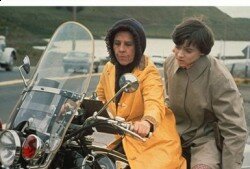
|
Remember what I said about no apologies for all these spring/autumn romances? Well, I’m going to turn the tables on this one. Hal Ashby’s (and he’s one of the most interesting filmmakers of the 1970s, in my opinion) Harold and Maude is one of the strangest movie pairings of all time. Hence the spot at number one. Harold is a rich, twenty year old man-boy who spends his time watching buildings getting demolished and faking suicides to gain attention from his mother. Maude is seventy-nine, an anarchist, and has a unique bent on life. They meet at a funeral. There you go. Boy meets girl. They spend time together, they might fall in love. Without a doubt, Maude changes Harold’s perspective on life. It’s all well and good to see an old man with a young woman, but I for one think it’s amazingly refreshing (even almost forty years later) to see a young man have his life turned around by a woman four times his age. Who says the oldies are redundant? A relationship forged on such a connection, between such polar opposites. Or are they opposites? I’ll let you be the judge. I also won’t reveal the ending. It’s not a matter of me being lazy, and it being way past my bed time. It’s a matter of wanting to share this film, and these two characters with you. Unconventional, perhaps. Irrelevant, certainly not!
